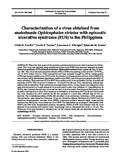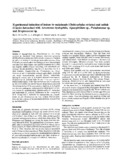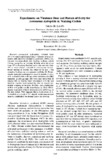| dc.contributor.author | Lio-Po, Gilda D. | |
| dc.contributor.author | Albright, Lawrence J. | |
| dc.contributor.author | Traxler, Garth S. | |
| dc.contributor.author | Leaño, Eduardo M. | |
| dc.date.accessioned | 2014-01-16T07:41:08Z | |
| dc.date.available | 2014-01-16T07:41:08Z | |
| dc.date.issued | 2001 | |
| dc.identifier.citation | Lio-Po, G. D., Albright, L. J., Traxler, G. S., & Leaño, E. M. (2001). Pathogenicity of the epizootic ulcerative syndrome (EUS)-associated rhabdovirus to snakehead Ophicephalus striatus. Fish Pathology, 36(2), 57-66. | en |
| dc.identifier.issn | 0388-788X | |
| dc.identifier.uri | http://hdl.handle.net/10862/1905 | |
| dc.description.abstract | The rhabdoviruses isolated from EUS-affected snakeheads in the Philippines was tested for pathogenicity to healthy, naive snakehead Ophicephalus striatus fry, fingerlings and juveniles. Virus exposure of naive snakehead fry and fingerlings by bath at 20-22.5°C resulted in significant mortalities (p<0.01) with no apparent lesions. Naive snakehead juveniles when injected intramuscularly (IM) with the EUS-associated rhabdovirus at ambient water temperature (28-32°C) did not develop any lesion. However, similarly treated snakehead juveniles at 20-22.5°C developed dermal lesions 3-5 days following treatment. The lesions progressed from slight to moderately advanced lesions by days 10-12 but not to deep ulcers as exhibited by naturally EUS-affected snakeheads. Mean mortalities were higher in the virus-injected fish (72%) compared to those in controls (33%). Moreover, the virus was reisolated from fish in the 20-22.5°C treatment but not from fish in the 28-32°C treatment. Virus from infected tissue filtrate and the virus passaged 3 or 4 times induced similar dermal lesions if the rhabdovirus concentration was 103 TCID50/fish or higher. When administered orally, by bath, by intraperitoneal (IP), IM and subdermal injections to snakehead juveniles, only the latter two viral routes induced dermal lesions. However, IP injection of the rhabdovirus caused 75% mortalities but none in control fish. The results demonstrate the pathogenicity of the rhabdovirus isolates to naive snakeheads at low (20-22.5°C) rearing water temperatures. | en |
| dc.description.sponsorship | Research funding was provided by the Aquaculture Department, Southeast Asian Fisheries Development Center and the International Development Research Centre (IDRC) of Canada (Fish Microbiology Project 3-P-88-1053-02). | en |
| dc.language.iso | en | en |
| dc.publisher | Japanese Society of Fish Pathology | en |
| dc.subject | Fish rhabdoviruses | en |
| dc.subject | Channa striatus | en |
| dc.subject | Snakehead | en |
| dc.subject | Epizootic ulcerative syndrome | en |
| dc.subject | EUS | en |
| dc.subject | pathogenicity | en |
| dc.title | Pathogenicity of the epizootic ulcerative syndrome (EUS)-associated rhabdovirus to snakehead Ophicephalus striatus | en |
| dc.type | Article | en |
| dc.citation.volume | 36 | |
| dc.citation.issue | 2 | |
| dc.citation.spage | 57 | |
| dc.citation.epage | 66 | |
| dc.citation.journalTitle | Fish Pathology | en |
| dc.subject.asfa | fish diseases | en |
| dc.subject.asfa | pathogens | en |
| dc.identifier.doi | 10.3147/jsfp.36.57 | |
| dc.subject.scientificName | Ophicephalus striatus | |
| dc.subject.scientificName | Channa striata | |



